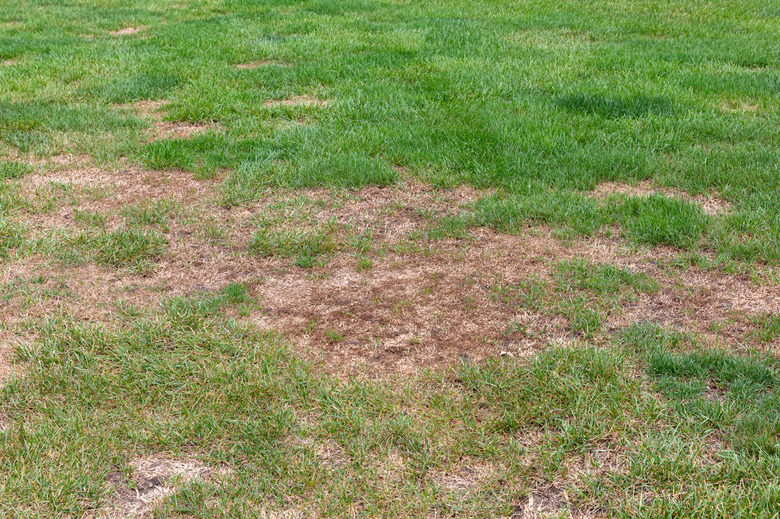Grub Control: How To Get Rid Of Lawn Grubs
Japanese beetles, chafers, June bugs, and other insects in the Scarabaeidae family, order Coleoptera, go through four developmental stages: egg, larvae, pupae, and adult. Grub is a general name given to the larval stage, which lives in soil and feeds on the roots of grass. The larvae of all these beetles are C-shaped, but they vary in size depending on the species and instar, or larval age. Light grub infestations do little harm, especially in healthy lawns, but heavy infestations destroy the turf's roots.
The adults typically lay their eggs in July, in full-sun areas of the lawn with adequate soil moisture. If you water your lawn because the weather is dry but your neighbors don't, your lawn will be an especially attractive target. In an infestation, the lawn wilts, browns, and dies in irregular patches. The affected area feels spongy underfoot, and the sod can be rolled back as if it were a piece of carpet, due to the severed roots of the grass plants. Another sign of grubs is damage from birds, skunks, raccoons, and opossums digging up lawns as they search for grubs to eat. Note that grubs don't typically live in shaded turf.
Grub problems generally manifest in late summer to mid-fall. Before doing anything, make sure the problem is indeed grubs; you could have drought stress, for example. To check if your problem spots are caused by grub activity, gently pull back the sod there to look for grubs, looking in the areas where brown and green grass meet. Healthy turf can support a grub population of five or so grubs per square foot with no problem. Ten or more grubs per square foot, however, can lead to lawn damage.
Natural Solutions to Grub Infestations
You can make a few cultural changes to discourage an infestation. Streetlights attract the adults at night, so damage frequently occurs beneath them; replacing the bulbs with sodium vapor or yellow lights makes them less appealing. And since the eggs require moisture, avoid watering the lawn in July and early August.
There are several biological options. One is to sic a parasite on the grubs. Heterorhabditis bacteriophora nematodes are very small unsegmented worms. They search out grubs and enter them to release deadly bacteria, but they have no detrimental effect on earthworms, ladybugs, and other helpful insects. This product is available online and in mail-order catalogs, often sold as Hb nematodes. Apply the nematodes at any time of the year when soil temperatures during the day are above 52 degrees Fahrenheit and soil-dwelling insects are present. Apply them late in the day to turf with adequate soil moisture; then water them in immediately.
Another option is to apply microbial products. Bacillus thuringiensis galleriae, found in products like grubGONE!, kills the larger second- and third-instar larvae without affecting plants, birds, bees, ladybugs, or aquatic species. The grubs must ingest the toxin, so after spraying or spreading the product, irrigate heavily. Chromobacterium subtsugae strain PRAA4-1T, in products such as Grandevo, also kills grubs, as well as some other insects and mites. Apply when the grubs are small and irrigate heavily after application.
Chemical Solutions for Killing Grubs
Insecticides that contain only bifenthrin, cyfluthrin, deltamethrin, gamma-cyhalothrin, lambda-cyhalothrin or permethrin are not effective for any phase of grub control.
Preventive Chemical Treatments
Preventive products are the most effective. They prevent future grub problems rather than controlling any grubs already present in the lawn in spring. Chemicals that contain chlorantraniliprole, clothianidin, imidacloprid, or thiamethoxam kill newly hatched grubs present in July, but they don't control later-stage grubs in the spring.
Some of these products are granular formulations designed for application with a fertilizer spreader, some get mixed with water and sprayed on, and still others come in bottles you attach to a garden hose to spray on. Apply these products in June or July (chlorantraniliprole can be applied as early as April, all the way to mid-July) to provide protection against the next generation of grubs, but only if you experienced grub damage the previous fall and found lots of grubs at that point.
Most of these products continue to be effective four to eight weeks after application, while chlorantraniliprole works for 12 to 16 weeks. Using a preventive insecticide for a year or two after an infestation allows you to grow denser, healthier turf that will be tolerant of grubs. If, after several years of treatment there's no evidence of grub damage, stop treating.
Warning
To protect bees, mow lawns immediately before using the chemicals described, as the chemicals are toxic to bees if they land on recently sprayed weeds that are in flower, such as clover.
Curative Chemical Treatments
Two chemicals, carbaryl and trichlorfon, are curative treatments to apply after the grubs have emerged and are actively feeding. These short-lived compounds kill all stages of grubs and are the only option if you find high numbers of grubs in autumn or before early May, but they're not as effective as preventive compounds in reducing grub numbers.
When using these chemicals, it's essential to irrigate with 1/2 inch of water immediately after application and to keep the lawn fertilized and watered afterward. Treat the lawn again with a preventive product the next summer to prevent recurrence of the problem in autumn or the following spring.
Rescue Chemical Treatments
If significant lawn damage is taking place or animals are digging in the area, the grubs may be in their third instar, meaning you'll need a rescue treatment. Products containing dinotefuran or trichlorfon are most effective at this time. The soil and thatch must be moist, and the application should be irrigated with 1/2 inch of water immediately afterward.
